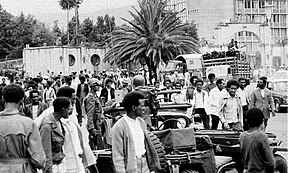
Back الحرب الأهلية الإثيوبية Arabic Guerra civil etíope AST ইথিওপিয়ার গৃহযুদ্ধ Bengali/Bangla Guerra Civil d'Etiòpia Catalan شەڕی نێوخۆییی ئەتیوپیا CKB Etiopská občanská válka Czech Äthiopischer Bürgerkrieg German Etiopia Enlanda Milito Esperanto Guerra civil etíope Spanish Etioopia kodusõda Estonian
This article needs additional citations for verification. (December 2022) |
| Ethiopian Civil War | |||||||||
|---|---|---|---|---|---|---|---|---|---|
| Part of the Eritrean War of Independence, the Ethiopian–Somali conflict, the Oromo conflict, the Cold War, and the Revolutions of 1989 | |||||||||
Clockwise from top: Public demonstration amid the Ethiopian Revolution; T-62 tank destroyed shortly after the fall of the Derg; Abandoned T-55 tank in northern Eritrea; Red Terror victims' skull remains at "Red Terror" Martyrs' Memorial Museum in Addis Ababa; Haile Selassie being deposed in the 1974 coup d'état | |||||||||
| |||||||||
| Belligerents | |||||||||
|
|
Supported by: | ||||||||
| Commanders and leaders | |||||||||
|
|
| ||||||||
| Strength | |||||||||
|
|
| ||||||||
| Casualties and losses | |||||||||
| Casualties and impact of the Ethiopian Civil War | |||||||||
|
≈400,000–579,000 killed[8][9][10] ~1,200,000 deaths from famine[8][9][11] | |||||||||
| History of Ethiopia |
|---|
 |
| History of Eritrea |
|---|
 |
|
|
The Ethiopian Civil War was a civil war in Ethiopia and present-day Eritrea, fought between the Ethiopian military junta known as the Derg and Ethiopian-Eritrean anti-government rebels from 12 September 1974 to 28 May 1991.
The Derg overthrew the Ethiopian Empire and Emperor Haile Selassie in a coup d'état on 12 September 1974, establishing Ethiopia as a Marxist–Leninist state under a military junta and provisional government. Various opposition groups of ideological affiliations ranging from Communist to anti-Communist, often drawn from a specific ethnic background, began armed resistance to the Soviet-backed Derg, in addition to the Eritrean separatists already fighting in the Eritrean War of Independence. The Derg used military campaigns and the Qey Shibir (Ethiopian Red Terror) to repress the rebels. By the mid-1980s, various issues such as the 1983–1985 famine, economic decline, and other after-effects of Derg policies ravaged Ethiopia, increasing popular support for the rebels. The Derg dissolved itself in 1987, establishing the People's Democratic Republic of Ethiopia (PDRE) under the Workers' Party of Ethiopia (WPE) in an attempt to maintain its rule.[12] The Soviet Union began ending its support for the PDRE in the late-1980s and the government was overwhelmed by the increasingly victorious rebel groups. In May 1991, the PDRE was defeated in Eritrea and President Mengistu Haile Mariam fled the country. The Ethiopian Civil War ended on 28 May 1991 when the Ethiopian People's Revolutionary Democratic Front (EPRDF), a coalition of left-wing ethnic rebel groups, entered the capital Addis Ababa. The PDRE was dissolved and replaced with the Tigray People's Liberation Front-led Transitional Government of Ethiopia.[13]
The Ethiopian Civil War left at least 1.4 million people dead, with 1 million of the deaths being related to famine and the remainder from combat and other violence.[12]
- ^ "Ethiopia: Crackdown in East Punishes Civilians". 3 July 2007.
- ^ Keneally, Thomas (27 September 1987). "IN ERITREA". The New York Times – via NYTimes.com.
- ^ ""Wir haben euch Waffen und Brot geschickt"". Der Spiegel. 2 March 1980 – via www.spiegel.de.
- ^ "Attempts to distort history". www.shaebia.org. Archived from the original on 17 November 2008. Retrieved 15 January 2022.
- ^ "Ethiopia-Israel". country-data.com. Retrieved 26 October 2014.
- ^ "Eritrea (01/06)". U.S. Department of State.
- ^ Schmid & Jongman 2005, pp. 538–539
- ^ a b Sanchez, Carlos (25 May 1991). "A Victory Tempered By Sorrow". Washington Post.
- ^ a b Henry, Neil (21 May 1991). "Mengistu Leaves Ethiopia in Shambles". Washington Post.
- ^ Obermeyer, Ziad; Murray, Christopher J L; Gakidou, Emmanuela (19 June 2008). "Fifty years of violent war deaths from Vietnam to Bosnia: analysis of data from the world health survey programme". BMJ. 336 (7659): 1482–1486. doi:10.1136/bmj.a137. ISSN 0959-8138. PMC 2440905. PMID 18566045.
- ^ Rapoport, Louis (28 April 1990). "Knives Are Out For A Bloodstained Ruler". Sydney Morning Herald.
- ^ a b Woldemariam, Michael; Woldgabreal, Yilma (November 2023). "Atrocity denial and emotions in the Ethiopian civil war". Elsevier. 73. doi:10.1016/j.avb.2023.101875. Retrieved 7 September 2024.
- ^ Valentino, Benjamin A. (2004). Final solutions: mass killing and genocide in the twentieth century. Cornell studies in security affairs. Ithaca (N.Y.): Cornell university press. p. 196. ISBN 978-0-8014-3965-0.




